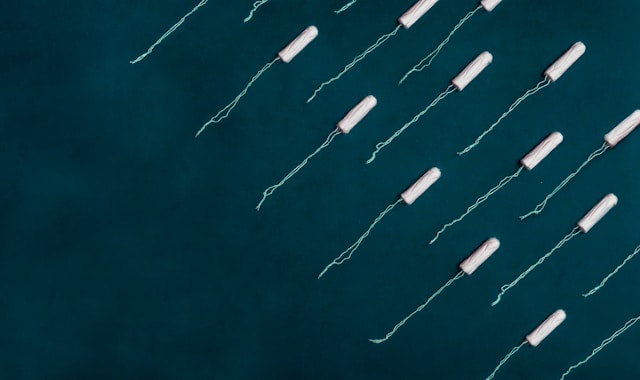Floating around the internet in recent weeks was an announcement from Argentinian researchers who, quite by accident, found that sterile women’s health products were anything but sterile. It turns out that cotton grown from genetically modified cotton seeds and sprayed with glyphosate across the growth cycle (RoundUp and other herbicides), retain, and likely leach, glyphosate from the products that the cotton is spun into. It should not be a surprise that those cotton-based products retain the chemicals from which they were grown or processed, but it was. Not because the idea is far-fetched, it isn’t. Indeed, it is biologically more likely that these chemicals are retained than it is that they somehow would magically disappear post processing. What was surprising is that we never thought about this before.
When we consider that 89% of cotton crops are now genetically modified to be glyphosate tolerant, the implications of glyphosate transfer from what are considered sterile medical and hygiene products directly into the bloodstream of the users should give us pause. Heck, it should have given us pause many years ago, but it didn’t and wouldn’t yet if it were not for some accidental finding in a lab studying something else entirely. This accident speaks volumes about how thoroughly we test, or rather, do not test, many of the products we have on the market. It is precisely this lack of testing and lack of understanding that leads to the preponderance of chronic health conditions from which so many in the Western world suffer.
Glyphosate and Women’s Health
If we look at women’s health in particular, I cannot help but wondering if glyphosate leaching tampons has something to do with the increase in menstrual related problems like fibroids, endometriosis, PCOS, and others. The female vagina and cervix are remarkably efficient vehicles for drug absorption. The vaginal epithelium provides a vast surface area that is richly vascularized and highly innervated. Drugs and other chemicals absorbed via this route directly enter the bloodstream and avoid detoxification via the liver, meaning lower dosages are required to reach the same effect as an orally ingested medication. Small concentrations, therefore, could induce large effects. And small, regular exposures to glyphosate is likely what we get from tampon use.
In addition to the ease with which certain chemical compounds can be absorbed through the vagina and the cervix, both also boast a very tightly regulated microcrobial environment that, when healthy, is capable of fending off all sorts of bacterial and viral threats on its own, absent medical intervention. Indeed, recent research shows that many medical interventions intended to promote health, destroy the vaginal bacterial balance, and ultimately, increase the risk of serious sexually transferred diseases, and viral, bacterial, and fungal infections.
In this context, one has to wonder, what could possibly go wrong when we directly and continuously expose a woman to a potent environmental toxicant for several days every month, month in and month out, year after year? If we look at the research from other modalities detailing damage by glyphosate, we see that quite a lot can go wrong and often does.
How Glyphosate Preparations Work
A little known fact that explains many of glyphosates ill-effects on plants, animals, and humans: before its life as the most commonly used herbicide on the planet, glyphosate was used as a commercial descaling agent. Yes, that is right, glyphosate is a powerful descalant able to attach to and remove the most tenaciously attached mineral buildup in pipes (calcium and magnesium, in particular). Consider how mineral deficiencies impact human health.
As an herbicide, the active ingredient of Roundup and many others, glyphosate is used with various chemical boosters called adjuvants. The chemical adjuvants added to glyphosate preparations boost the potency of glyphosate alone, allowing it to penetrate cell walls more easily. Glyphosate is never used in isolation, but always with an adjuvant. So when I refer to glyphosate within this document, I am referring to the glyphosate herbicides with associated boosters.
Glyphosate is toxic to all plant life – all, not just some, but all plant life. Glyphosate kills plants via the disruption of a particular enzyme (enolpyruvylshikimate-3-phosphate synthase –EPSPS) required to synthesize essential amino acids. Of note, these amino acids comprise approximately 30% plant dry mass and contribute largely to the dietary needs of the larger animals and humans (one of the many reasons GM foods are nutrient reduced compared to organic).
The EPSPS enzyme is present in all plants, fungi, and many bacteria (including the bacteria that populate human skin, lungs, gut and reproductive regions). When this enzyme is blocked, organismal death is imminent via necrosis, a very messy form of cell death.
In order for crops to survive glyphosate spraying, they are modified to include either two copies of EPSPS enzyme or a strain resistant to these chemicals. These modifications allow farmers to spray glyphosate liberally, killing the weeds and other pests while protecting the crop. The plants are modified to resist the glyphosate, but not metabolize it. That means that glyphosate residues remain in and on the plant that is destined to become food or, in this case, cotton; cotton that is used in all sorts of applications from clothing to medical and hygiene products. (Glyphosate also remains in the soil and leaches into the surface and ground water).
Just as the ramifications of ingesting glyphosate modified foods are vast and complicated (see here, here, here and here for background), so too are the likely consequences of direct exposure to glyphosate and its adjuvants via skin contact or via the vaginal epithelia. With both local and systemic changes at play, understanding the potential consequences of glyphosate leaching tampons is difficult at best.
Glyphosate’s Mechanisms of Destruction – CYP Enzymes
Top on the list of glyphosate’s most detrimental activities, is its ability to disrupt critical enzymes. Glyphosate alters the body’s innate metabolic enzymes – the CYP450 enzymes – through multiple mechanisms and in a variety of directions; some of these enzymes are upregulated, while others are downregulated. The CYP enzymes are the proteins responsible for ensuring the metabolism of steroids, some vitamins (vitamins A and D), drugs, and environmental chemicals. There are also CYP enzymes that regulate what is called hemostasis (blood clot formation and dissolution), particularly important topic for women who also utilize hormonal contraception. Mess with these proteins and all sorts of things go wrong; mess with them directly, in a tightly regulated local environment like the vagina and it is possible, if not probable, that many of the problems we see in women’s reproductive health can be tracked back to these exposures.
Glyphosate Is an Endocrine Disruptor
Glyphosate’s ability to alter steroidogenesis directly via upregulating or downregulating the CYP enzymes responsible for steroid synthesis makes it one of the more potent endocrine disruptors. Glyphosate, it seems, disturbs steroidogenic enzymes at every turn, from top to bottom of the pathway.
The first step involved in making steroid hormones requires that cholesterol be transported into the mitochondria and converted by an enzyme called StAR into the mother hormone of all steroids – pregnenolone. Pregnenolone becomes progesterone and from there, depending upon the tissue within which these processes are occurring, progesterone can be converted to a whole bunch of other steroid hormones. Glyphosate downregulates StAR, effectively throwing a wrench in the entire steroidogenic machine. And if it does this in vaginal, cervical, or uterine cavity, a region hugely dependent upon a symphony of steroid hormones, I’d imagine there would be some problems. StAR is not the only enzyme involved in steroid balance that glyphosate interrupts.
Glyphosate can increase or decrease aromatase (CYP19) depending upon cell type. Since aromatase metabolizes testosterone into estradiol, glyphosate dysregulates estradiol concentrations. In the Leydig cells (male testicular cells), glyphosate increases aromatase, effectively reducing testosterone while increasing estradiol concentrations – not a healthy balance for male reproductive capacity. Consider in utero development of a male offspring. In contrast, in placental cells, glyphosate decreases aromatase, effectively decreasing estradiol and the other estrogens needed to maintain a healthy placenta. Worse yet, glyphosate is toxic to human placental cells in culture.
These are just the tip of the hormone-disruption iceberg. Glyphosate alters enzymes throughout the steroidogenic pathways in patterns we are only beginning to understand. Imagine the possible hormone disruption evoked by a lifetime of direct exposure via tampons leaching glyphosate into the vaginal epithelium, a surface replete with a full complement of hormone receptors, local steroidogenic machinery, and a direct connection to an ample blood supply so that these chemicals can do systemic harm. It’s difficult to imagine that this would be good, and yet, that is exactly where we find ourselves with GM cotton used in the production of tampons.
But wait, there’s more.
Glyphosate Disrupts Vitamin A Metabolism
Vitamin A? What do vitamins have to do with the vaginal epithelium (or the epithelia of any other body surface)? A lot. Vitamins and minerals are important co-factors of every bodily enzyme and a whole bunch of other stuff. Without proper nutrients, the enzymes responsible for the machinery that keeps us alive and kicking slows to a crawl and all sorts of chronic and intractable disease processes arise. In the case of vitamin A (retinoic acid is the active form in the body), the proper balance is so critical that disruption evokes everything from blindness, tumors, and cancers, to reproductive difficulties and many gynecological conditions such as endometriosis and fibroids. If one can get pregnant, glyphosate exposure is linked to severe congenital malformations in the offspring. Vitamin A balance is not something to be messed with, and yet, we do.
I’ve written about the Vitamin A pathway before and am likely to do so again, as this particular set of mechanisms merits a much deeper dive. Glyphosate’s impact on the retinoic acid pathway are complicated and the effects of disruption are far-reaching and diverse.
Briefly, glyphosate interacts with the metabolism of vitamin A at multiple junctures within the cascade, changing everything from receptor activity, and signal transduction, to what proteins are transcribed and how, and whether or not damaged DNA can repair itself (too much glyphosate and it cannot). What makes this pathway particularly difficult to understand is that it is tightly and locally regulated. Moreover, it has complicated cascades of compensatory reactions to maintain proper vitamin A concentrations that vary by location (compartment in pharmacological parlance), and more specifically, by cell type. Too much or too little vitamin A in one tissue and cell type does not always produce the same reactions in different cells. Making matters worse yet, the enzymes that regulate vitamin A synthesis and metabolism are largely competitive with other compounds. Endogenous and synthetic hormones and alcohol compete with vitamin A for enzyme activity. That means too much or too little estradiol or synthetic estrogens (from oral contraceptives, HRT, environmental estrogens, even from glyphosate itself) change how retinoic acid is used within any given cell by altering enzyme activity. Ditto for alcohol use.
With regard to women’s health, there is a growing body of evidence linking low vitamin A synthesis and activity within leiomyomas – fibroid tumors and in endometriosis cells. There is also evidence that chronic low level exposures to glyphosate initiates fibroid tissue growth in rodents. Similarly, from cancer research, we know that within many tumor types the machinery for vitamin A is disrupted and ultimately decreased such that local administration decreases tumor size. Together this suggests that certain types of aberrant cell growth and death may be linked to impaired vitamin A machinery, perhaps mediated by toxicant exposure.
To summarize, glyphosate disrupts hormone and vitamin balance and, in doing so, risks creating an environment of tumorogenesis and carcinogenesis both locally, systemically, and likely generationally, with a range of detrimental effects to us and our offspring.
But wait, there’s more.
Glyphosate Is an Anti-Microbial
Remember when I mentioned that the vagina, the cervix, and indeed, the entire uterine cavity contain a unique and highly efficient ecosystem of microbes that are capable of eradicating a wide range of pathogens independent of medical intervention? Well, glyphosate, which was designed to be antibiotic and is patented as such, disrupts bacterial ecosystems. It appears the good bacteria, like the Lactobacilli dominant in the vagina, are highly susceptible to glyphosate’s antibacterial tendencies while the bad bacteria, the bacteria that cause all sorts of infections, are not. Just like the medical antibiotics given to fight infections tend to disrupt microbial balance and have spurred the growth of super-pathogens, strains of bacteria that are resistant to all currently available antibiotics, glyphosate appears to do the same. Though the potency and dosages of residue glyphosate ingested by diet or absorbed intravaginally are likely reduced compared to medical antibiotics, the chronicity of exposure is incomparable. And if we have learned anything from the more advanced toxicology methods of recent decades, it is that smaller, continuous exposures tend to produce as significant ill-effects as the larger ones.
Perhaps not considered as deeply as it should be, when we disrupt bacterial populations with persistent antibiotics, we not only increase the prevalence of more virulent bacterial pathogens that are resistant to antibiotic therapies, but encourage the growth of more virulent fungal infections, like glabrata infections, now common with the increased use of bactericidal antibiotics like fluoroquinolones. Viral infections too can become more problematic. HPV and HIV, for example increase in women who use hormonal contraceptives. The mechanism suspected is the altered vaginal/cervical pH. Since Lactobacilli maintain the acid environment of the vaginal area and glyphosate kills lactobacilli, the ensuing change in pH by glyphosate alone, would increase a woman’s risk of serious viral infections. Add a hormonal contraceptive, and her innate protection is likely diminished significantly.
And last, but certainly not least.
Glyphosate Disrupts Hemostasis
One of the least well understand actions of glyphosate is its impact on blood clotting mechanisms. There is emerging evidence amongst a lot of speculation, that glyphosate disrupts the CYP enzymes involved in maintaining proper blood clotting: CYP5A1 – (thromboxane synthase) and CYP8A1 – (prostacylin synthase). This is particularly problematic for women who use hormonal contraception where the risk of developing blood clots is significantly higher than in the population as a whole. Additionally, here is where I think we’ll find the roots of the most common complaints amongst menstruating women – excessive menstrual bleeding along with increased menstrual blood clots. If we can map glyphosate’s role in bleeding, along with its role in vitamin A balance, I suspect we can shed light on some of the pressing health issues that women face. A second post on this topic is necessary. For now, suffice it to say, glyphosate likely disrupts local, and potentially more systemic, clotting mechanisms.
Now What?
Honestly, I have no idea. This is quite overwhelming. Tampons are a wonderful invention and it is not feasible for women, especially athletic women, to stop using tampons (and yes, I know about menstrual cups, but they too have potential problems with polymers that could leach endocrine disrupting chemicals). Would organic products be better? Probably, but there will always be chemicals used in the processing of these products; in the adhesives, the absorbents, and other component parts. I am not sure we can fully remove ourselves from the chemical environment, at least not immediately. With some effort, however, I think we could change the dynamics of this situation within a generation or so. Perhaps it is time for women take control of these businesses or start new ones and develop safer products. It is certainly past time for women to demand better and safer products for themselves and their children.
Postscript
Since this article was published in 2015, to my knowledge, there has been only one additional study addressing glyphosate in tampons or other hygiene products. A review article published in 2022, found 24 studies addressing various chemical compounds in these products (metals, phthalates, dioxins, VOCs, bisphenols, and others) and only 3 studies involving the measurement of these compounds in human women. With the exception of a study from Belgium, where glyphosate use is restricted and banned in some areas, none of these studies assessed glyphosate exposure. In the majority of studies, however, chemicals used in the growth and production of these cotton products were identified in the tampons and pads and per the human studies, despite serious limitations in methodology, chemical exposure was confirmed.
We Need Your Help
More people than ever are reading Hormones Matter, a testament to the need for independent voices in health and medicine. We are not funded and accept limited advertising. Unlike many health sites, we don’t force you to purchase a subscription. We believe health information should be open to all. If you read Hormones Matter, like it, please help support it. Contribute now.
Yes, I would like to support Hormones Matter.
This article was published originally on November 2, 2015.












